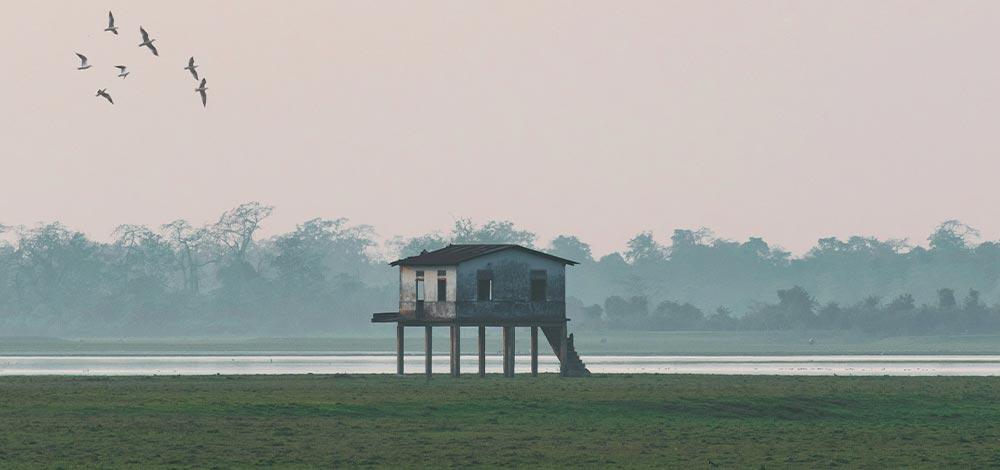What is Duar Formation?
Last Updated :
31 Jan, 2023
Duar formations are geological structures that occur in certain mountainous regions around the world. They are characterized by a series of parallel ridges and valleys that have been formed by erosion and tectonic activity.
In the Indian context, duars refer to the floodplains situated around the Himalayas, in the state of Assam in the North-East and in the north of West Bengal. The altitude of duars varies from a minimum of 90 m to a maximum of 1750 m. It is also referred to as silts, in case of river overflow, floods occur and leave behind sediments classified mostly as duars.

Duar Formation in Assam
Duar Formations
Duar formations are geological structures that are typically found in mountainous regions and are formed by a combination of erosion and tectonic activity. These formations can be found in many different parts of the world and are known for their unique and striking landscapes. In this article, we will discuss the formation of duars, the different types of duars, and the impact that these formations have on the surrounding environment. Duar formations are not only a visual delight but also a valuable source of information for geologists, who can study these formations to understand the history of the earth’s crust and the processes that shape it. Duar formations are a valuable resource for scientists, naturalists, and adventurers, who can study and explore these unique landscapes. Duar Formations are a series of alluvial terraces and floodplains located in the northeastern region of India and the neighboring country of Bangladesh. These formations are characterized by their unique geomorphological features and ecological significance.
History of Duar Formation
The formation of Duars can be traced back to the late Tertiary period, around 25 million years ago. The region was once covered by a vast sea, and over time, the sea level started to recede, leaving behind a series of alluvial terraces and floodplains. The Duars are formed by the deposition of sediment carried by the Brahmaputra and its tributaries. The sediment gets deposited in the form of alluvium, and over time, the alluvium gets consolidated to form terraces and floodplains.
Characteristics of Duar Formation
The Duars are characterized by their unique geomorphological features such as the presence of extensive gravels, boulders, and cobbles. The terraces are typically composed of sandstone and shale, while the floodplains are composed of clay and silt. The Duars are also characterized by their rich biodiversity, with a wide variety of flora and fauna found in the region. The Duars are of significant economic importance to the region. The terraces and floodplains are used for agriculture, with a wide variety of crops such as rice, jute, and sugarcane grown in the region. The Duars are also known for their tea gardens, which are a major source of income for the local population. The region is also rich in minerals such as coal, limestone, and clay, which are extracted for industrial use.
The Duars is also an important ecological zone, with a wide variety of flora and fauna found in the region. The region is known for its rich biodiversity, and is home to a wide variety of plants, animals, and birds. The Duars are an important habitat for many endangered species such as the one-horned rhinoceros, elephant, tiger, and many species of deer and primates.
Ways of Formation
Duar formations are typically formed by a combination of erosion and tectonic activity. The movement of tectonic plates can create an uplift in the earth’s crust, which is then worn away by erosion. The type of rock and the climate of the region can also play a role in the formation of duars. For example, regions with a high amount of rainfall and soft rock will be more susceptible to erosion, forming duars.
In conclusion, Duar formations are not only beautiful to look at, but they also hold a wealth of information for geologists who study them to understand the history and processes that shape the earth’s crust. These formations are a valuable resource for scientists, naturalists, and adventurers alike, as they offer a unique opportunity to study and explore these unique landscapes.
FAQs on Duar Formation
Question 1: What is duar formation?
Answer:
Duar formations are typically formed by a combination of erosion and tectonic activity. The movement of tectonic plates can create uplift in the earth’s crust, which is then worn away by erosion.
Question 2: What is the main characteristic of a duar formation?
Answer:
The main characteristic of a duar formation is a series of parallel ridges and valleys.
Question 3: What are some examples of duar formations?
Answer:
Some examples of duar formations are the Himalayan Duars in India and Bhutan, and the Great Dividing Range in Australia.
Like Article
Suggest improvement
Share your thoughts in the comments
Please Login to comment...